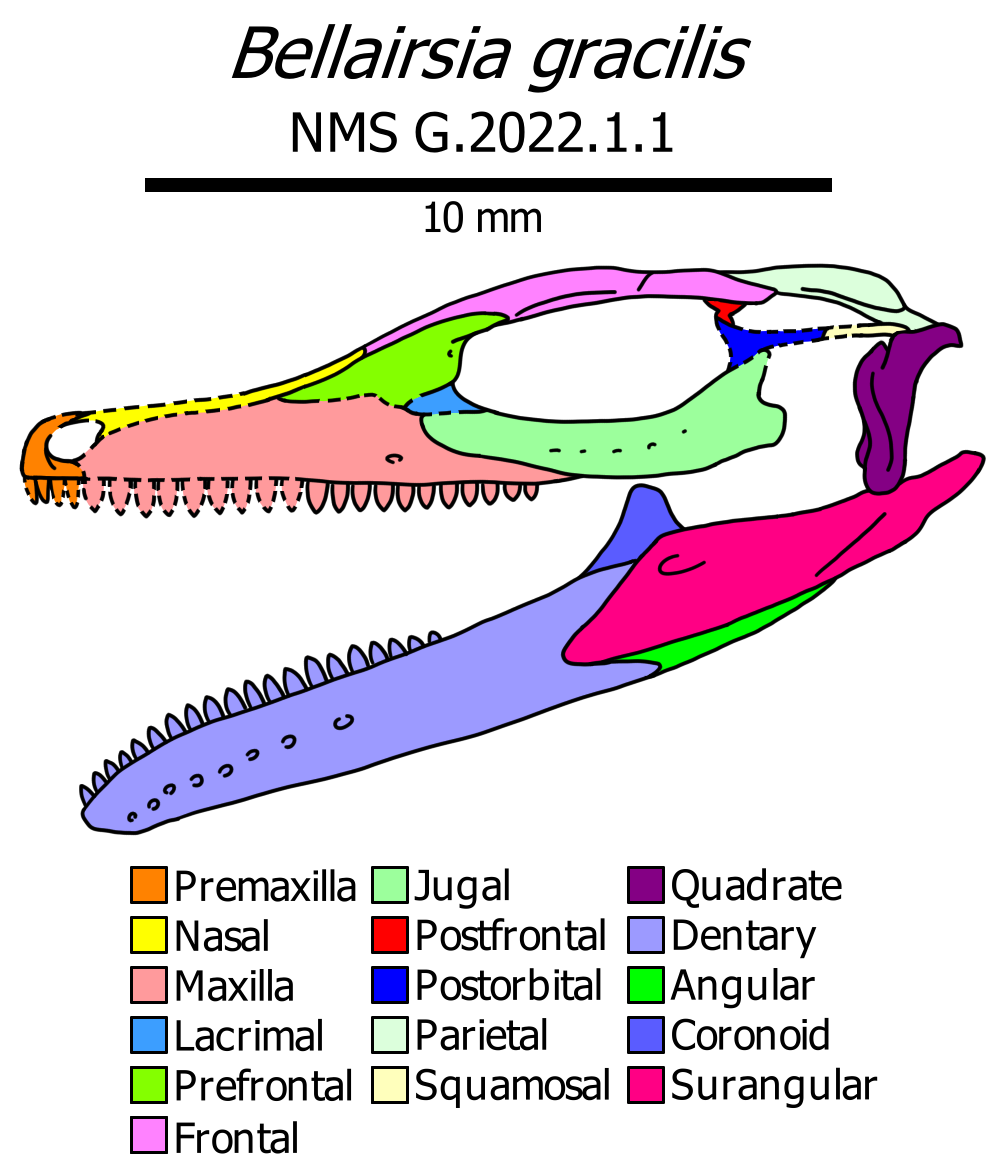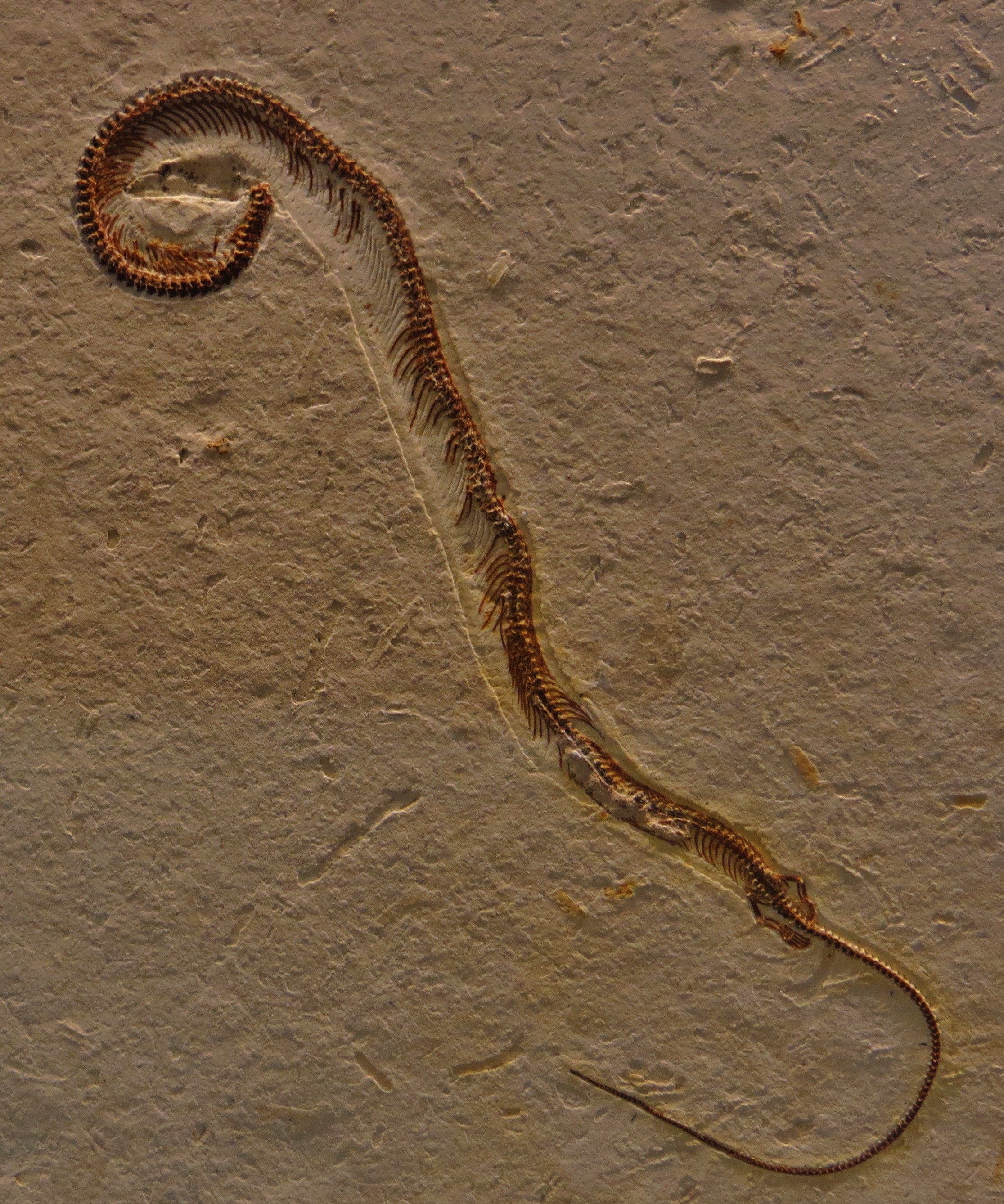|
Bellairsia
''Bellairsia'' is an extinct genus of stem- squamate known from a single species, ''Bellairsia gracilis'', from the Middle Jurassic (Bathonian) of England and Scotland. It is amongst the oldest squamates known. It was originally described in 1998 by Susan E. Evans from disarticulated individual bones, including the holotype dentary, collected from the Forest Marble Formation in Kirtlington Quarry, Oxfordshire, England. It was named in honor of British herpetologist and vertebrate anatomist Angus Bellairs. In 2022, a partial 70% complete skeleton was described from the equivalently aged Kilmaluag Formation of the Isle of Skye, Scotland. The partial skeleton had an estimated snout-vent length of around . While originally considered a member of Scincomorpha, the 2022 study recovered it to be a stem-group squamate, with the phylogeny recovering it as part of a weakly supported clade also containing ''Huehuecuetzpalli'' and ''Oculudentavis''. Classification Phylogeny A phy ... [...More Info...] [...Related Items...] OR: [Wikipedia] [Google] [Baidu] |
Oculudentavis
''Oculudentavis'' is an extinct genus of lizard of uncertain taxonomic placement,Bolet et al., 2021 originally identified as an avialan dinosaur (bird, in the broad sense). It contains two known species, ''O. khaungraae'' and ''O. naga''. Each species is known from one partial fossil specimen in Burmese amber, which differ in several proportions. Their skulls measure in length, indicating that ''Oculudentavis'' would have been comparable in size with the modern bee hummingbird if it were an avialan. Both specimens were retrieved from 99-million-year-old deposits of the Hukawng Basin in Kachin State, northern Myanmar. The type specimen of ''O. khaungraae'' is embroiled in controversy regarding its identity and the ethical issues surrounding the acquisition and study of Burmese amber. The original description advocating for an avialan identity was published in ''Nature'', but has since then been retracted from the journal.Xing et al., 2020 retraction Discovery and naming '' ... [...More Info...] [...Related Items...] OR: [Wikipedia] [Google] [Baidu] |
Forest Marble Formation
The Forest Marble is a geological formation in England. Part of the Great Oolite Group, it dates to the late Bathonian stage of the Middle Jurassic.Weishampel, David B; et al. (2004). "Dinosaur distribution (Middle Jurassic, Europe)." In: Weishampel, David B.; Dodson, Peter; and Osmólska, Halszka (eds.): The Dinosauria, 2nd, Berkeley: University of California Press. Pp. 538–541. . Lithology The primary lithology of the formation typically consists of greenish grey variably calcareous silicate mudstone, with lenticular cross bedded limestone units deposited in a marine setting. Dinosaurian fauna Ornithischians Saurischians Microvertebrate fauna Despite the formation being nearly entirely marine, at several localities abundant remains of terrestrial microvertebrates are found, the primary locality being the Kirtlington Mammal Bed (designated 3p) in Kirtlington Quarry near Kirtlington, Oxfordshire. Another important locality is Watton Cliff near Eype in Dorset. Amp ... [...More Info...] [...Related Items...] OR: [Wikipedia] [Google] [Baidu] |
Kilmaluag Formation
The Kilmaluag Formation is a Middle Jurassic geologic formation in Scotland. It was formerly known as the Ostracod Limestone for the abundance of fossil freshwater ostracods within it. The Kilmaluag Formation is very fossiliferous, with ostracods, gastropods, bivalves, trace fossil burrows, and vertebrate fossil remains. Vertebrate fossils include fish, crocodylomorphs, mammals, small reptiles, amphibians and some large reptile remains including dinosaurs and pterosaurs.Panciroli E, RBJ Benson, S Walsh, RJ Butler, TA Castro, MEH Jones, SE. Evans. 2020Diverse vertebrate assemblage of the Kilmaluag Formation (Bathonian, Middle Jurassic) of Skye, Scotland Earth and Environmental Transactions of the Royal Society of Edinburgh nline1-22 Geology The Kilmaluag Formation is Bathonian, and dates to around 167 million years old. It is part of the Great Estuarine Group of the Hebrides Basin, a series of sediments laid down as the land rose and fell in the area running between what is now ... [...More Info...] [...Related Items...] OR: [Wikipedia] [Google] [Baidu] |
Angus Bellairs
Angus d'Albini Bellairs (11 January 1918 – 26 September 1990) was a British professor of vertebrate morphology and a specialist in herpetology. He published a landmark two volume ''The Life of Reptiles'' (1970). Bellairs studied at Stowe School, Queen's College, Cambridge, and University College London. He joined the Royal Army Medical Corps in 1942 and served in north Africa, the Middle East, Italy, India and Burma. On his travels he took an interest in natural history and collected numerous specimens. After military service he obtained a comparative anatomy position in the department of human anatomy at the London Hospital Medical College, followed by similar positions at Cambridge University and St. Mary's Hospital Medical School. In 1970 he became Professor of Vertebrate Anatomy in the University of London. Some of his major contributions to herpetology where on the function of Jacobson's organ The vomeronasal organ (VNO), or Jacobson's organ, is the paired auxiliary olfac ... [...More Info...] [...Related Items...] OR: [Wikipedia] [Google] [Baidu] |
Paliguana
''Paliguana'' is an extinct genus of lizard-like lepidosauromorph reptile from the earliest Triassic Katberg Formation (Beaufort Group) in the upper ''Lystrosaurus'' Assemblage Zone of South Africa South Africa, officially the Republic of South Africa (RSA), is the southernmost country in Africa. It is bounded to the south by of coastline that stretch along the South Atlantic and Indian Oceans; to the north by the neighbouring countri .... It is currently the earliest known lepdosauromorph. References *''Bringing Fossils To Life: An Introduction To Paleobiology'' by Donald R. Prothero Early Triassic reptiles of Africa Permian reptiles of Africa Fossils of South Africa Fossil taxa described in 1903 Prehistoric reptile genera {{Permian-reptile-stub ... [...More Info...] [...Related Items...] OR: [Wikipedia] [Google] [Baidu] |
Megachirella
''Megachirella'' is an extinct genus of stem-squamate that lived about 240 million years ago during the Middle Triassic and contains only one known species, ''Megachirella wachtleri''. It is known from a partial skeleton discovered in the Dolomites of Northern Italy and was described in 2003. Description ''Megachirella'' is known exclusively from a partial skeleton, preserved in anatomical connection. The find includes an almost complete skull, the front half of the body and part of the front legs. The skull, although devoid of the front part of the snout, is rather robust and large; the neck is moderately elongated and the front legs are large and strong. The dimensions do not exceed in length, and the appearance is similar to that of a strong-legged lizard. Classification Megachirella was discovered in the Dont Formation of the area of Braies, in South Tyrol, and described in 2003. It was classified as a member of Lepidosauromorpha, the clade of reptiles that includes lizards, ... [...More Info...] [...Related Items...] OR: [Wikipedia] [Google] [Baidu] |
Fraxinisaura
''Fraxinisaura'' is an extinct genus of basal (phylogenetics), basal lepidosauromorph reptile known from the Middle Triassic of Germany. The only known species is ''Fraxinisaura rozynekae''. It possessed an elongated snout, unique features of the teeth, and an Ilium (bone), ilium (upper hip bone) which was intermediate in orientation between Rhynchocephalia, sphenodontians (the branch of Lepidosauria, lepidosaurs including the tuatara) and Squamata, squamates (the branch including Lizard, lizards). Based on characteristics of the maxilla, it is considered a close relative of ''Marmoretta'' from the Middle Jurassic of the United Kingdom, resolving a ghost lineage between that genus and other Triassic basal lepidosauromorphs. Discovery Remains of ''Fraxinisaura'' have only been recovered from the Schumann limestone quarry near Vellberg, Vellberg, Germany. Stratigraphically, it hails from the Untere Graue Mergel Layer of the Erfurt Formation, also known as the Lower Keuper. The Lowe ... [...More Info...] [...Related Items...] OR: [Wikipedia] [Google] [Baidu] |
Marmoretta
''Marmoretta'' is an extinct genus of small lepidosauromorph reptile known from the Middle Jurassic (late Bathonian age) of Oxfordshire, England and Skye, Scotland. It contains a single species, ''Marmoretta oxoniensis''. Etymology ''Marmoretta'' was first described and named by Susan E. Evans in 1991 and the type species is ''Marmoretta oxoniensis''. The generic name is derived from Latin ''marmoros'', meaning "Marble" and refers to the Forest Marble Formation - the source of the initial specimens of ''Marmoretta''. The specific name is derived from ''Oxonia'', the Latinised form of "Oxford", in reference to Oxfordshire. Discovery ''Marmoretta'' is known from holotype BMNH R.12020, the anterior region of a right maxilla. Many specimens are referred to the species from the type locality, and together represent a nearly complete skull. All specimens are housed in the Natural History Museum. They were collected from the Mammal Bed of the Forest Marble Formation, at Kirtlin ... [...More Info...] [...Related Items...] OR: [Wikipedia] [Google] [Baidu] |
Crown Group
In phylogenetics, the crown group or crown assemblage is a collection of species composed of the living representatives of the collection, the most recent common ancestor of the collection, and all descendants of the most recent common ancestor. It is thus a way of defining a clade, a group consisting of a species and all its extant or extinct descendants. For example, Neornithes (birds) can be defined as a crown group, which includes the most recent common ancestor of all modern birds, and all of its extant or extinct descendants. The concept was developed by Willi Hennig, the formulator of phylogenetic systematics, as a way of classifying living organisms relative to their extinct relatives in his "Die Stammesgeschichte der Insekten", and the "crown" and "stem" group terminology was coined by R. P. S. Jefferies in 1979. Though formulated in the 1970s, the term was not commonly used until its reintroduction in 2000 by Graham Budd and Sören Jensen. Contents of the crown gr ... [...More Info...] [...Related Items...] OR: [Wikipedia] [Google] [Baidu] |
Lepidosauria
The Lepidosauria (, from Greek meaning ''scaled lizards'') is a subclass or superorder of reptiles, containing the orders Squamata and Rhynchocephalia. Squamata includes snakes, lizards, and amphisbaenians. Squamata contains over 9,000 species, making it by far the most species-rich and diverse order of reptiles in the present day. Rhynchocephalia was a formerly widespread and diverse group of reptiles in the Mesozoic Era. However, it is represented by only one living species: the tuatara (''Sphenodon punctatus),'' a superficially lizard-like reptile native to New Zealand. Lepidosauria is a monophyletic group (i.e. a clade), containing all descendants of the last common ancestor of squamates and rhynchocephalians. Lepidosaurs can be distinguished from other reptiles via several traits, such as large keratinous scales which may overlap one another. Purely in the context of modern taxa, Lepidosauria can be considered the sister taxon to Archosauria, which includes Aves (birds) and ... [...More Info...] [...Related Items...] OR: [Wikipedia] [Google] [Baidu] |
Archosauromorpha
Archosauromorpha (Greek for "ruling lizard forms") is a clade of diapsid reptiles containing all reptiles more closely related to archosaurs (such as crocodilians and dinosaurs, including birds) rather than lepidosaurs (such as tuataras, lizards, and snakes). Archosauromorphs first appeared during the late Middle Permian or Late Permian, though they became much more common and diverse during the Triassic period. Although Archosauromorpha was first named in 1946, its membership did not become well-established until the 1980s. Currently Archosauromorpha encompasses four main groups of reptiles: the stocky, herbivorous allokotosaurs and rhynchosaurs, the hugely diverse Archosauriformes, and a polyphyletic grouping of various long-necked reptiles including ''Protorosaurus'', tanystropheids, and ''Prolacerta''. Other groups including pantestudines (turtles and their extinct relatives) and the semiaquatic choristoderes have also been placed in Archosauromorpha by some authors. A ... [...More Info...] [...Related Items...] OR: [Wikipedia] [Google] [Baidu] |
Sophineta
''Sophineta'' is an extinct genus of basal lepidosauromorph reptile known from the Early Triassic (late Olenekian age) of Małopolska Province, southern Poland. It contains a single species, ''Sophineta cracoviensis''. Discovery ''Sophineta'' was first described and named by Susan E. Evans and Magdalena Borsuk−Białynicka in 2009, and the type species is ''Sophineta cracoviensis''. It is known from holotype ZPAL RV/175, a nearly complete right maxilla. Many isolated or associated skull and postcranial fragments are referred to the species, representing frontals, parietals, prefrontal, postfrontals, postorbitals, jugals, squamosals, pterygoids, quadrates, maxillae, premaxilla, dentaries, vertebrae and ilia. ''Sophineta'' fossils were discovered ''in situ'' and collected in 1982 by a team (Paszkowski and Wieczorek) from the Institute of Geological Sciences of Jagiellonian University in Kraków. They were collected from the Czatkowice 1 locality, a single exposure near Kr ... [...More Info...] [...Related Items...] OR: [Wikipedia] [Google] [Baidu] |




